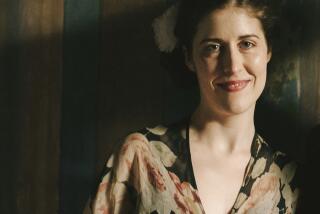Review: Think you know Sylvia Plath? Read this definitive new biography
- Share via
On the Shelf
Red Comet: The Short Life and Blazing Art of Sylvia Plath
By Heather Clark
Knopf: 1,152 pages, $40
If you buy books linked on our site, The Times may earn a commission from Bookshop.org, whose fees support independent bookstores.
Sylvia Plath long ago reached, even overshot, iconic status. From the moment of her death in 1963, her life and work have been transcribed onto many narratives, including but not limited to ambition, motherhood, the American dream, anti-Semitism, postwar poetry, mental illness and, most powerfully, feminism. With Heather Clark’s new biography, “Red Comet,” clocking in at more than 1,100 pages, the Plath cup runneth over.
It’s exactly this transference that makes a Plath biography challenging. The melodrama of her life and its horrific conclusion overwhelms the fact that above all, Plath was a poet. The literary estate’s iron fist in doling out permissions hasn’t helped. Books on Plath fell into two camps: the personal — even sensational — and the academic. Now, after nearly half a century, new information has emerged, old grudges been buried. The result is Clark’s defining project, both a joyful affirmation for Plath fanatics and a legitimization of her legacy.
Plath herself is a dream for scholars. Anticipating interest in her letters, she kept a diary from a very young age and dated all correspondence and drafts with confidence in her legacy. Clark is the first biographer able to scan pages from the archive rather than take “hastily scribbled” notes on site, and it shows. Details of family history, including her grandmother’s institutionalization for depression and the FBI’s investigation of her German father, appear for the first time here.
Clark benefits from recent discoveries in an already robust archive. In 2017, scholars discovered 14 letters between Plath and her former psychiatrist, Dr. Ruth Beuscher, shedding new light on Plath’s mental state in the final months of her life. One letter includes an accusation that her husband, poet Ted Hughes, beat Plath so severely while she was pregnant that she miscarried. Though his emotional abuse is well-documented, the physical violence is new.
As the author of “The Grief of Influence,” a book on Plath and Hughes’ marriage and creative partnership, Clark is well aware that Hughes is both a stumbling block and a litmus test. If you vilify him, you are accused of bias. If you are too kind to him, you are accused of being anti-Plath or, even worse, anti-women.
Hughes called his new bride his “secretary in chief,” and indeed it was Plath who submitted the manuscript for “The Hawk in the Rain,” the book that would launch Hughes’ career. Though Hughes did help Plath with brainstorming and childcare in a way that was unusual for the time, he did not promote her work for publication. He would only repay that debt after her death.
Where Clark treads familiar ground, she amplifies what we already know in compelling and painful ways. Any reader of “The Bell Jar” is aware of the horrors of electroconvulsive therapy, but the revelation that Plath received four ECT treatments without anesthesia before her 1953 suicide attempt is devastating. After surviving that attempt, she was committed to McLean Hospital, where she underwent six more treatments of ECT.
Equally revealing is Plath’s relationship with Beuscher. Assigned to Plath at McLean, Beuscher had recently gone through a divorce and lost custody of her two children. The two struck up a friendship after Plath was discharged in January 1954 — a relationship well outside the bounds of what would be considered appropriate between a patient and therapist.
One of the benefits of such a long-delayed biography is the advance of medical knowledge. Today we know more about the hormonal effects of pregnancy and childbirth on the brain, though more research is desperately needed. When Plath and Hughes separated over his affair, their son Nicholas was just 6 months old.
“According to Ted and [his sister] Olwyn, who both read Sylvia’s last journal, Sylvia had contemplated taking the children ‘with her’ when she killed herself. This was one of the reasons Hughes claimed to have burned part of Plath’s last journal,” Clark explains. “Thoughts of harming one’s children are symptomatic of severe postpartum depression, known as postpartum psychosis, which in 20 percent of cases can last ‘beyond the first year of delivery.’”
Another reader of that last journal could have been Ted’s mistress, Assia Wevill, who — six years after Plath — did take her 4-year-old child by Hughes “with her” when she took her own life. Clark’s inclusion of Assia’s fate in a biography of Plath shows how inextricable Hughes — and his mistreatment of women — are from the Plath mythos.
It isn’t just modern hindsight that renders “Red Comet” uniquely complete: it’s old sources newly procured. Plath’s contemporaries were interviewed by Harriet Rosenstein for a Plath biography she never completed; her notes were only made available by Emory University in 2020. It is harrowing to read of her closest friends scrambling to prevent what now seems inevitable. Elizabeth Compton, to whom “The Bell Jar” is dedicated, went to the flat to see the children with her daughter Meg, who had long brown hair just like Plath’s at the time of her death. When baby Nicholas saw Meg, “he climbed on her and held her hair,” Compton remembered. “Awful, awful.”
Former U.S. Poet Laureate Natasha Trethewey always wrote of public pain and private struggle. Her memoir, “Memorial Drive,” lets her mother speak.
Plath’s biographical details are so rich that they can overdetermine her work — or obscure it entirely. This is where Clark’s monolithic chronicle not only excels but justifies the project: in its illumination of the development of Plath’s craft. Only in a biography this comprehensive can you get a sense of her intense trajectory and the transcendent achievement that is her poetry. When her father was dying, Plath’s mother kept the children downstairs to let him rest undisturbed. When he did come down to eat dinner after they had gone to bed, Clark relays, he would find poems Plath had written for him under his napkin. Plath’s father died a week after her eighth birthday.
“She challenged the male Romantic notion that the moorland outside her door was more sublime than her baby’s nursery,” Clark writes. “She is one of the first poets in English to write about miscarriage, abortion, and postpartum anxiety.”
Clark masterfully analyzes the poetry with intelligent incorporation of the biography. One particularly sensitive analysis concerns the poem “Ariel”; Clark tells us the original interruption in the poem was sexual. But Plath changed it to a maternal distraction — “The child’s cry / Melts in the wall.” As Clark writes, “‘Ariel’ became the first poem in English that confronts the risks and burdens of maternity for the woman poet.”
Much has been made of the fact that “The Colossus” was the only book of poetry Plath ever saw in print, and that “The Bell Jar” was only published in the U.K. under a pseudonym. But on every single page of this biography — what feels like every week of her life — Sylvia Plath was publishing! She saw her work in print constantly. In this mammoth biography of a short, troubled life, the deepest impression is of her resilience and dogged energy.
In her 1956 poem “Black Rook in Rainy Weather,” Plath writes:
...Miracles occur
If you care to call those spasmodic
Tricks of radiance miracles. The wait’s begun again,
The long wait for the angel,
For that rare, random descent.
“Red Comet” shows that the achievement of Sylvia Plath was miraculous — but it wasn’t spasmodic, or rare. It was hard-won, every single day.
Over the last three months, 17 writers provided diaries to The Times of their days in isolation, followed by weeks of protest. This is their story.
Ferri, a writer based in Berkeley, is the author of “Silent Cities: New York.”
More to Read
Sign up for our Book Club newsletter
Get the latest news, events and more from the Los Angeles Times Book Club, and help us get L.A. reading and talking.
You may occasionally receive promotional content from the Los Angeles Times.







